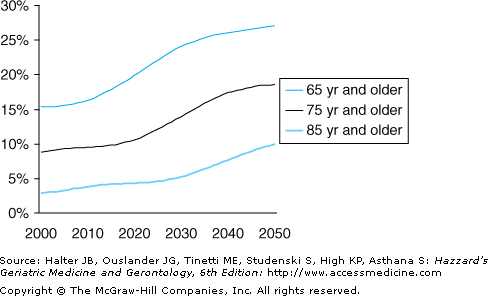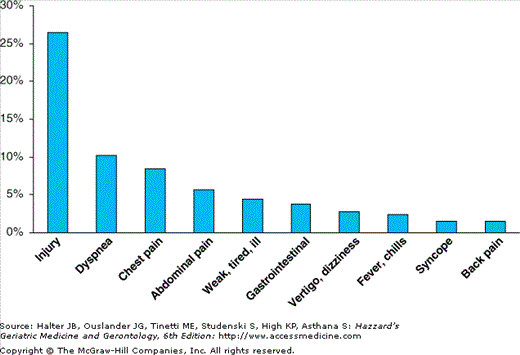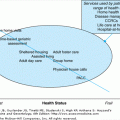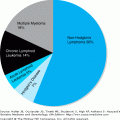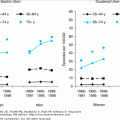Emergency Department Care: Introduction
The emergency department (ED) plays a unique and essential role in the care of the older adult. The ED is open 24 hours a day, seven days a week, 365 days a year. It provides access to the millions of people who have no other entry point for health care. It gives care to people who have no established community provider and acts as the gatekeeper between the community and the hospital.
The prevailing model of care in EDs has been established for over 40 years but does not conform well to the needs of the older adult. Based on principles proposed in 1962 by the Committee on Trauma of the American College of Surgeons (ACS), EDs are designed for rapid evaluation and treatment of the emergent and urgent needs of acutely ill and injured patients. ED care differs from care delivered in other settings. Typically, there is no preexisting relationship between the patient and the physician. The process rewards speed, the timeframe is immediate, and the focus is on the patient’s complaint. It is not friendly to the older patient with complex needs who require thorough assessment and evaluation and whose care process is slow-moving.
In the 1990s, the Society for Academic Emergency Medicine (SAEM) Geriatric Task Force proposed a model of emergency care for older patients (Table 18-1). The model appreciates differences in disorders and diagnoses by age, atypical presentation of disease, altered physiology of aging, the complexity of diagnosis, and management of older patients, and the need to consider other issues beyond the presenting complaint. The Geriatric Task Force recognized that symptoms may be nonspecific, comorbidities are common, and response to therapy is often difficult to predict. The Task Force proposed a biopsychosocial model of emergency care for older patients. The model has evolved over time and reflects the current thinking about basic principles for emergency care of the older patient.
|
The ED plays a crucial role in care for seniors. Older people use the ED at higher rates than other populations, present more often with urgent and emergent conditions, and are more frequently transported by ambulance. In addition, the ED is a major care provider for nursing home residents; one of four nursing home residents is transported to an ED yearly.
Emergency medicine has only recently identified the older population as a group with special needs, but interest in the area is growing exponentially. The first journal article to address the emergency care of elders was by published in 1967 and concerned emergency surgery. There were 39 other articles cited for the years 1966 to 1970. From 2001 to 2005, there were 1267 entries, which represents over a 30-fold increase. A major contributor to the growth of geriatric emergency room (ER) medicine was a seminal series of articles in the Annals of Emergency Medicine. The articles emerged from a project to evaluate the care of elders in United States EDs, funded by the John A. Hartford Foundation and carried out by the SAEM Geriatric Emergency Medicine Task Force. The task force reviewed the literature and conducted surveys of emergency physicians and residency program directors, reviewed ER records, and held focus groups. The task force found that the evidence base for ED care of the older adult was small and that the discipline had failed to plan ED care to meet the needs of elders. Given the expected growth of the aging population in coming decades and the high volume of ED use among them, there was concern that emergency medicine training programs have no organized content on care for older ED patients and that there have been no organized advocates within either emergency medicine or geriatrics to spearhead change in emergency health care for seniors.
It cannot be known whether the SAEM reports stimulated action to address these concerns, or whether change was inevitable. Without question, the reports brought ED care for the older adult to the attention of leaders within emergency medicine and geriatrics. Today, the SAEM and the American College of Emergency Physicians (ACEP) are represented on a Council of Medical Specialties hosted by the American Geriatrics Society. Moreover, both SAEM and ACEP have developed working groups who focus on older emergency patients. Today, emergency medicine training programs include geriatric content and the qualifying examinations include questions directed at care of older patients.
Epidemiology
The aging of the U.S. population poses a challenge to health care delivery, as older patients consume a disproportionate share of health care resources. Emergency care is one area of heavy resource use by older patients. In 2004, approximately 14% of the 110 million ED visits were by patients aged 65 years and older. Compared to younger patients, older patients have higher levels of disease acuity and the probability of hospital admission from the ED is higher. In one study, 40% of older adults in the ED were admitted, compared to 10% of younger adults. Older adults were also more likely to be admitted to critical care units (4% vs. <1%), more likely to undergo laboratory and radiographic testing, and had longer ED lengths of stay.
Given the high rate of ED use by older adults and the projected growth of the older populations, ED use by older adults will increase further in the future (Figure 18-1). Assuming stable visit rates, the proportion of ED visits that are by older patients will increase to approximately 25% by the year 2030. In recent years, however, ED visit rates by older people have grown 26%, which is higher than any other segment of the population. Thus the combined effects of an aging population and increasing ED use rates could push the proportion of older adults in the ED even higher.
The presenting complaints of older patients differ from those of younger patients. The most common ED-presenting complaint for both older and younger patients is injury, though this complaint is even more common in younger patients (37%) than older patients (26%). Other common reasons for ED visits are shown in Figure 18-2 and include dyspnea, chest pain, and abdominal pain. The 10 chief complaints in Figure 18-2 comprise about two-thirds of all ED chief complaints for older patients.
Pathophysiology and Presentations
In past years, the role of the emergency physician was primarily triage—determining which patients were ill and required further inpatient work-up and which were safe to be discharged. With the substantial increase in the quality and quantity of available diagnostic tests, this role has shifted. The primary role of the emergency physician is now diagnosis. Most often, the correct diagnosis will be made in the ED. However, there are times when making the correct diagnosis is not possible and the focus is on ruling out serious disease. In many instances, emergency physicians also treat the disease they have diagnosed, though it is not uncommon for the patients to require treatment that exceeds the capability of the emergency physician. Given the high proportion of older patients who require hospital admission, the treatment of many older patients exceeds the care that can be provided in the ED.
ED use sometimes has negative connotations. Many physicians seem apologetic when referring a patient to the ED and an ED visit is sometimes even considered a type of adverse outcome in research. These negative connotations may be based on a faulty perception of the role of the ED in the care of older patients. Since the older patient has a higher probability of serious disease, the ED may provide the best place to accomplish diagnosis and treatment of potentially dangerous undifferentiated complaints with relative speed compared to traditional inpatient and outpatient settings.
Typical ED approaches to diagnosis may not work well with the older patient. Older patients may present with undifferentiated complaints that have a broad differential diagnosis encompassing numerous serious diseases. Common diseases may present atypically. Cognitive impairment may limit the ability to obtain an accurate history. Older patients may tend to minimize symptoms; attributing a symptom to a benign rather than a more serious condition. For example, an older ED patient may suggest that their chest pain is due to indigestion rather than heart attack or their abdominal pain is constipation rather than ischemic bowel. Typical presenting signs and symptoms may be absent, and diagnostic tests may be normal despite serious diseases. For these reasons, an extensive evaluation may be appropriate to sort out the complexities of the situation. While commonly considered a sign of poor judgment and derogatively described as “shotgunning,” with the complex older patient, extensive evaluation may be the most thoughtful approach.
Acute cardiac ischemia may be especially difficult to diagnose in the older patient. In the younger-old (e.g., 65–85 years), the majority of patients have chest pain, although atypical presentations can occur. After age 85 years, atypical presentations of cardiac ischemia outnumber typical ones by a 2:1 margin. Common atypical presentations include altered mental status, abdominal pain, dyspnea, and arrhythmia. In fact, acute delirium or change in level of consciousness (stupor or coma) can sometimes be the single presenting symptom of what turns out to be acute cardiac ischemia. Conversely, altered mental status is only rarely due to acute cardiac ischemia; it is the cause of record in only 1% of patients who present to the ED with acute mental status changes.
Abdominal pain in the older adult also presents challenges in the ED. For example, among older patients with acute cholecystitis, most do not have epigastric or right upper quadrant pain, and 5% do not have any pain at all. Over half will be afebrile, and nearly half will have a normal white blood cell count. Only one in five older patients with appendicitis present classically, less than half have an elevated temperature, and a quarter have atypical tenderness on examination that is either diffuse or localized to an area other than the right lower quadrant. In contrast to younger patients with abdominal pain, lack of abnormal laboratory studies or a normal body temperature in an older patient would not help rule out the need for surgical intervention. The nonspecific presentation of serious abdominal disease in the older adults has led to increased reliance on the use of computed tomography, which has a much higher sensitivity and specificity than the clinical examination in the evaluation of the older patient with abdominal pain.
Evaluation
The Geriatric Emergency Care Model (Table 18-1) outlines an approach to older ED patients that differs from the approach to younger patients. In addition to assessing the chief complaint, the care model encourages routine assessment of cognitive and functional status.
